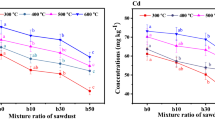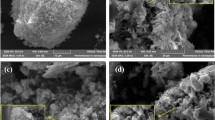Abstract
Pyrolysis is a promising technique used for treating of sewage sludge. However, the application of pyrolysis products is limited due to the presence of heavy metals. In this study, sewage sludge mixed with kaolin/zeolite was pyrolyzed in a rotary kiln, aiming to improve the immobilization of heavy metals in pyrolytic carbon. The total concentrations, speciation distributions, leaching toxicities, and potential ecological risk indices of heavy metals in pyrolysis biochar were explored to examine the effects of kaolin/zeolite and pyrolytic temperature on immobilizing heavy metals. Further, mineral composition and surface morphology of biochar were characterized by X-ray diffraction and scanning electron microscopy to reveal the potential mechanism of immobilizing heavy metals. Increasing pyrolysis temperature facilitated the stabilization of heavy metals in pyrolysis biochar. The proportions of stable heavy metals in biochar obtained at 650°C were 54.50% (Cu), 29.73% (Zn), 79.29% (Cd), 68.17% (Pb) and 86.70% (Cr). Compared to sewage sludge, the potential contamination risk index of pyrolysis biochar obtained at 650°C was reduced to 17.01, indicating a low ecological risk. The addition of 7% kaolin/zeolite further reduced the risk index of co-pyrolysis biochar prepared at 650°C to 10.86/15.28. The characterization of biochar revealed that increase in the pyrolysis temperature and incorporation of additives are conducive to the formation of stable heavy metal-inorganics. This study demonstrates that the formation of stable mineral compounds containing heavy metals is the key to stabilizing heavy metals in pyrolysis biochar.

Similar content being viewed by others
References
Devi P, Saroha A K (2014). Risk analysis of pyrolyzed biochar made from paper mill effluent treatment plant sludge for bioavailability and eco-toxicity of heavy metals. Bioresource Technology, 162: 308–315
Du H, Zhong Z, Zhang B, Shi K, Li Z (2020). Comparative study on pyrolysis of bamboo in microwave pyrolysis-reforming reaction by binary compound impregnation and chemical liquid deposition modified HZSM-5. Journal of Environmental Sciences-China, 94: 186–196
Du H, Zhong Z, Zhang B, Zhao D, Lai X, Wang N, Li J (2021). Comparative study on intercalation-exfoliation and thermal activation modified kaolin for heavy metals immobilization during high-organic solid waste pyrolysis. Chemosphere, 280: 130714
Gandidi I M, Susila M D, Pambudi N A (2017). Co-cracking of real MSW into bio-oil over natural kaolin. 1st International Symposium on Green Technology for Value Chains 2016, Tangerang. London: Institute of Physics Publishing
Gu W, Bai J, Dong B, Ma E, Chen J, Wang J (2019). Heavy metals speciation and its bioavailability in sewage sludge pyrolysis residue. SN Applied Sciences, 1(9): 8–15
Gupta T, Sachdeva S N (2020). Study of mechanical, micro-structural and environmental properties of concrete containing zinc industry waste for pavements. Construction & Building Materials, 245: 118331–118341
Hu Y, Yang F, Chen F, Feng Y, Chen D, Dai X (2018). Pyrolysis of the mixture of MSWI fly ash and sewage sludge for co-disposal: Effect of ferrous/ferric sulfate additives. Waste Management (New York, N. Y.), 75: 340–351
Jiao F, Zhang L, Dong Z, Namioka T, Yamada N, Ninomiya Y (2016). Study on the species of heavy metals in MSW incineration fly ash and their leaching behavior. Fuel Processing Technology, 152: 108–115
Jin J, Wang M, Cao Y, Wu S, Liang P, Li Y, Zhang J, Zhang J, Wong M H, Shan S, Christie P (2017). Cumulative effects of bamboo sawdust addition on pyrolysis of sewage sludge: Biochar properties and environmental risk from metals. Bioresource Technology, 228: 218–226
Kamali N, Mehrabadi A, Mirabi M, Zahed M (2020). Synthesis of vinasse-dolomite nanocomposite biochar via a novel developed functionalization method to recover phosphate as a potential fertilizer substitute. Frontiers of Environmental Science & Engineering, 14(4): 70
Kim D G, Nhung T T, Ko S O (2016). Enhanced adsorption of heavy metals with biogenic manganese oxide immobilized on zeolite. KSCE Journal of Civil Engineering, 20(6): 2189–2196
Kobayashi Y, Ogata F, Nakamura T, Kawasaki N (2020). Synthesis of novel zeolites produced from fly ash by hydrothermal treatment in alkaline solution and its evaluation as an adsorbent for heavy metal removal. Journal of Environmental Chemical Engineering, 8(2): 103687–103692
Li J, Yu G, Xie S, Pan L, Li C, You F, Wang Y (2018). Immobilization of heavy metals in ceramsite produced from sewage sludge biochar. Science of the Total Environment, 628–629: 131–140
Li J, Zhong Z, Ma Y, Lai X, Li Z (2020). Adsorption mechanism of PbO/PbCl2 on kaolinite surfaces during coal combustion based on Frontier Orbital Theory. Energy & Fuels, 34(9): 11258–11269
Liu L, Huang L, Huang R, Lin H, Wang D (2021). Immobilization of heavy metals in biochar derived from co-pyrolysis of sewage sludge and calcium sulfate. Journal of Hazardous Materials, 403: 123648
Liu Y, Ran C, Siddiqui A R, Siyal A A, Song Y, Dai J, Chtaeva P, Fu J, Ao W, Deng Z, Jiang Z, Zhang T (2020). Characterization and analysis of sludge char prepared from bench-scale fluidized bed pyrolysis of sewage sludge. Energy, 200: 117398
Mukherjee A, Lal R, Zimmerman A R (2014). Effects of biochar and other amendments on the physical properties and greenhouse gas emissions of an artificially degraded soil. Science of the Total Environment, 487: 26–36
Pariyar P, Kumari K, Jain M K, Jadhao P S (2020). Evaluation of change in biochar properties derived from different feedstock and pyrolysis temperature for environmental and agricultural application. Science of the Total Environment, 713: 136433
Peng C, Zhai Y, Hornung A, Li C, Zeng G, Zhu Y (2018). Promoting effect of ZSM-5 catalyst on carbonization via hydrothermal conversion of sewage sludge. ACS Sustainable Chemistry & Engineering, 6(7): 9461–9469
Proch F, Bauerbach K, Grammenoudis P (2021). Development of an up-scalable rotary kiln design for the pyrolysis of waste tyres. Chemical Engineering Science, 238: 116573
Ran C, Liu Y, Siddiqui A R, Siyal A A, Mao X, Kang Q, Fu J, Ao W, Dai J (2019). Pyrolysis of textile dyeing sludge in fluidized bed: Analysis of products, and migration and distribution of heavy metals. Journal of Cleaner Production, 241: 118308
Salimova A, Zuo J, Liu F, Wang Y, Wang S, Verichev K (2020). Ammonia and phosphorus removal from agricultural runoff using cash crop waste-derived biochars. Frontiers of Environmental Science & Engineering, 14(3): 48
Shao J, Yuan X, Leng L, Huang H, Jiang L, Wang H, Chen X, Zeng G (2015). The comparison of the migration and transformation behavior of heavy metals during pyrolysis and liquefaction of municipal sewage sludge, paper mill sludge, and slaughterhouse sludge. Bioresource Technology, 198: 16–22
Shen T, Tang Y, Lu X Y, Meng Z (2018). Mechanisms of copper stabilization by mineral constituents in sewage sludge biochar. Journal of Cleaner Production, 193: 185–193
Shi W, Liu C, Ding D, Lei Z, Yang Y, Feng C, Zhang Z (2013). Immobilization of heavy metals in sewage sludge by using subcritical water technology. Bioresource Technology, 137(6): 18–24
Su P, Gao X, Zhang J, Djellabi R, Yang B, Wu Q, Wen Z (2021). Enhancing the adsorption function of biochar by mechanochemical graphitization for organic pollutant removal. Frontiers of Environmental Science & Engineering, 15(6): 130
Sun S, Huang X, Lin J, Ma R, Fang L, Zhang P, Qu J, Zhang X, Liu Y (2018). Study on the effects of catalysts on the immobilization efficiency and mechanism of heavy metals during the microwave pyrolysis of sludge. Waste Management (New York, N.Y.), 77: 131–139
Tang S, Zheng C, Yan F, Shao N, Tang Y, Zhang Z (2018). Product characteristics and kinetics of sewage sludge pyrolysis driven by alkaline earth metals. Energy, 153: 921–932
Wendt J O L, Lee S J (2010). High-temperature sorbents for Hg, Cd, Pb, and other trace metals: Mechanisms and applications. Fuel, 89(4): 894–903
Xu Y, Qi F, Bai T, Yan Y, Wu C, An Z, Luo S, Huang Z, Xie P (2019). A further inquiry into co-pyrolysis of straws with manures for heavy metal immobilization in manure-derived biochars. Journal of Hazardous Materials, 380: 120870
Xue C, Wu J, Wang K, Yi Y, Fang Z, Cheng W, Fang J (2021). Effects of different types of biochar on the properties and reactivity of nano zero-valent iron in soil remediation. Frontiers of Environmental Science & Engineering, 15(5): 101
Yang Z, Xing R, Zhou W, Zhu L (2020). Adsorption characteristics of ciprofloxacin onto g-MoS2 coated biochar nanocomposites. Frontiers of Environmental Science & Engineering, 14(3): 41
Yu J, Zhang X, Jin B, Chen J, Huang Y, Wang Z (2021). Silica aluminum xerogel-based sorbent for removal of volatilized PbCl2 during the incineration: Improvement on mass-transfer limitations via high porosity. Science of the Total Environment, 782: 146925
Yu M, Huang Y, Xia W, Zhu Z, Fan C, Liu C, Dong L, Xu L, Liu L, Zha J, Wang X (2020). PbCl2 capture by kaolin and metakaolin under different influencing factors of thermal treatment. Energy & Fuels, 34(2): 2284–2292
Yuan X Z, Huang H J, Zeng G M, Li H, Wang J Y, Zhou C F, Zhu H N, Pei X K, Liu Z F, Liu Z T (2011). Total concentrations and chemical speciation of heavy metals in liquefaction residues of sewage sludge. Bioresource Technology, 102(5): 4104–4110
Yuan X, Leng L, Huang H, Chen X, Wang H, Xiao Z, Zhai Y, Chen H, Zeng G (2015). Speciation and environmental risk assessment of heavy metal in bio-oil from liquefaction/pyrolysis of sewage sludge. Chemosphere, 120: 645–652
Yue Y, Cui L, Lin Q, Li G, Zhao X (2017). Efficiency of sewage sludge biochar in improving urban soil properties and promoting grass growth. Chemosphere, 173: 551–556
Zha J, Huang Y, Clough P T, Xia Z, Zhu Z, Fan C, Yu M, Yan Y, Cheng H (2021). Green production of a novel sorbent from kaolin for capturing gaseous PbCl2 in a furnace. Journal of Hazardous Materials, 404: 124045–124052
Zhang D, He S, Dai L, Xie Y, Wu D, Bu G, Peng K, Kong H (2009). Impact of pyrolysis process on the chromium behavior of COPR. Journal of Hazardous Materials, 172(2–3): 1597–1601
Zhang Z K, Li A M, Liang X Y (2014). Effects of basicity (CaO/SiO2) on the behavior of heavy metals from sludge incineration ash by vitrification treatment. Advanced Materials Research, 878: 284–291
Acknowledgements
This study was funded by National Key Research and Development Program of China (No. 2018YFC1901202).
Author information
Authors and Affiliations
Corresponding author
Additional information
Highlights
• Adding kaolin/zeolite promotes the formation of stable heavy metals.
• The potential ecological risk index of copyrolysis biochar is extremely low.
• Increasing the pyrolysis temperature reduces the leaching toxicity of heavy metals.
• The toxicity of biochar reduces with the increasing content of stable heavy metals.
Supplementary materials
Rights and permissions
About this article
Cite this article
Li, Q., Zhong, Z., Du, H. et al. Co-pyrolysis of sludge and kaolin/zeolite in a rotary kiln: Analysis of stabilizing heavy metals. Front. Environ. Sci. Eng. 16, 85 (2022). https://doi.org/10.1007/s11783-021-1488-1
Received:
Revised:
Accepted:
Published:
DOI: https://doi.org/10.1007/s11783-021-1488-1




